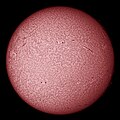Chromosphere
A chromosphere ("sphere of color") is the second layer of a star's atmosphere. It is located above the photosphere and below the solar transition region and corona. The term usually refers to the Sun's chromosphere, but not only.
In the Sun's atmosphere, the chromosphere is about 3,000 to 5,000 kilometers (1,900 to 3,100 miles) in height, or a little more than 1% of the Sun's radius at maximum thickness. It possesses a homogeneous layer at the border with the photosphere. Hair-like jets of plasma, called spicules, rise from this homogeneous area and through the chromosphere, extending up to 10,000 km (6,200 mi) into the corona above.
The chromosphere has a usual and expected red color due to electromagnetic emissions in the Hα spectral line. Information about the chromosphere is mostly received by analysis of its given-off electromagnetic radiation.[1]
Chromospheres have also been followed on stars other than the Sun.[2] On large stars, chromospheres sometimes make up a significant proportion of the whole star. For example, the chromosphere of supergiant star Antares has been found to be about 2.5 times larger in thickness than the star's radius.[3]
Chromosphere Media
The red color of the chromosphere could be seen during the solar eclipse of August 11, 1999.
References
- ↑ Jess, D.B; Morton, RJ; Verth, G; Fedun, V; Grant, S.T.D; Gigiozis, I. (July 2015). "Multiwavelength Studies of MHD Waves in the Solar Chromosphere". Space Science Reviews. 190 (1–4): 103–161. arXiv:1503.01769. Bibcode:2015SSRv..190..103J. doi:10.1007/s11214-015-0141-3. S2CID 55909887.
- ↑ "The Chromosphere". Archived from the original on 2014-04-04. Retrieved 2014-04-28.
- ↑ "Supergiant Atmosphere of Antares Revealed by Radio Telescopes". National Radio Astronomy Observatory. Retrieved 9 September 2022.



